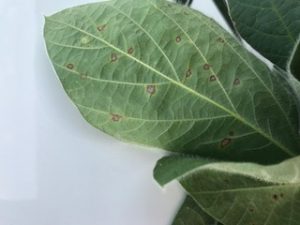Last week I gave an update on the diseases we are starting to see in parts of Illinois corn. We have had a few decent rain events, the most recent yesterday, which have dropped temperatures somewhat and increased humidity throughout parts of the state. I expect we will start to see some diseases pop up in some of our crops within the next 7-14 days, so it is important to scout and check your growth stages. The following are the diseases we most likley will see take off in the next two weeks.
1) White mold in soybeans. This is not a disease that causes annual widespread losses in the state, typically due to lack of irrigation, heat, and potentially other factors. However, when weather is favorable, outbreaks can occur. Soybeans in the northern part of the state, especially those in the NW quadrant, are likely at elevated risk. Disease in general is favored by closed canopies, cooler temperatures, and most importantly humidity/rain. Flowering through early pod set typically is when fields will see the greatest impacts. Research has shown that labeled fungicides can provide suppression, and return a profit, especially in high disease situations, when applied between flowering and early pod set. Dr. Damon Smith at UW Madison has done a lot of work on this system over the past 7 years. You can access additional information they have generated on the topic here.
2) Northern corn leaf blight and grey leaf spot in corn. We have seen a few lesions in fields across the state where crop development is still hasn’t hit VT. Expect disease severity to increase, especially in susceptible hybrids. Scout, check your growth stage, and check your hybrid ratings. Resistant hybrids are not likely to require a fungicide application. The greatest benefit will be in high yield fields of continuous no till corn, where susceptible hybrids are planted.
3) Corn tar spot. Recent conditions likely will result in elevated tar spot, especially in the northwest quadrant through Dekalb County. I expect we will see noticeable signs of tar spot in canopies within the next two weeks, as opposed to the 5 stroma in a 500 acre field situation we saw previously. All materials are susceptible to tar spot to a degree. If you start to see this one in your canopies and you are near that VT-R3 window, a labeled premix fungicide can provide a benefit. Remember that revenge sprays aren’t going to help you here, those applications need to get on before the disease takes hold. If you are in a high risk area and were thinking about a fungicide, check your fields for yield potential, and evaluate if a fungicide application makes sense for you. If we run into another pattern of wet weather, this one can blow up fast
4) Southern rust. Reports of southern rust have popped up in central Missouri and Arkansas over the past week. Last night’s front likely blew some inoculum into southwest and west central Illinois. Most hybrids are highly susceptible to this one, and it does not require much moisture to continue to develop once established.
5) Frogeye leaf spot. This one is interesting, as typically we see it at greater levels in the southern part of the state where a warmer climate and topography favors the development of hanging dews. However, some have stated that they are seeing more in central IL and areas where historically this hasn’t been an issue. In Iowa, where flare ups occurred, resistance to strobilurins was also observed. We would like to start looking at this throughout Illinois in more depth, as much of our data is nearing a decade in age, and is focused primarily on the sourthern portion of the state. Feel free to contact us (nathank@illinois.edu) if you start to see FLS pop up at noticeable levels where perhaps it hasn’t been an issue in the past. Avoid applying a QoI only fungicide product if possible to reduce the chance of QoI resistance development and subsequent fungicide failure.

